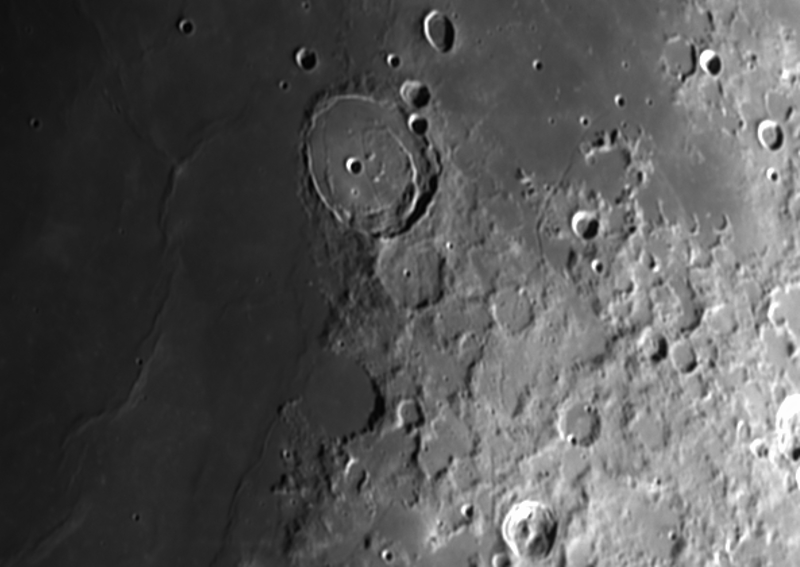Posidonius is a lunar impact crater that is located on the north-eastern edge of Mare Serenitatis, to the south of Lacus Somniorum. It was named after ancient Greek philosopher and geographer Posidonius of Apamea. The crater Chacornac is attached to the southeast rim, and to the north is Daniell.
Oblique view of Posidonius from Apollo 17. Note that the lava which flooded the crater reached its rim and is clearly above the mare plain to the west (left).
The rim of Posidonius is shallow and obscured, especially on the western edge, and the interior has been overlain by a lava flow in the past. The crater ramparts can still be observed to the south and east of the crater rim, and to a lesser degree to the north.
There is a smaller, semi-circular rim of a concentric, flooded crater within the main rim, offset towards the eastern edge. There is no central peak, but the floor is hilly and laced with a rille system named the Rimae Posidonius. The floor is also slightly bulged due to the past lava uplift, which also likely produced the complex of rilles. The northeast rim is interrupted by the smaller crater Posidonius B. Within the crater rim, offset just to the west of center is another smaller crater Posidonius A.
On the Mare Serenitatis surface near Posidonius is a notable system of wrinkle ridges that parallel the nearby shore. These are designated the Dorsa Smirnov. At the peak of these ridges is a small craterlet (Posidonius Y) with a diameter of 2 km. This craterlet is surrounded by a patch of high-albedo material, and is an example of a lunar bright spot. This peak was formerly designated Posidonius Gamma (γ).
Posidonius Gamma was first observed by the lunar cartographer Julius Schmidt in 1867, who noted the similarity to the bright patch surrounding the crater Linné.
Posidonius es un cráter de impacto lunar que está situado en el extremo nororiental del Mare Serenitatis, al sur del Lacus Somniorum. El cráter Chacornac está unido al borde sureste, y al norte se halla el cráter Daniell.
El borde de Posidonius es oscuro y poco profundo, especialmente en el borde occidental. Su interior ha sido cubierto por flujos de lava en el pasado. Los taludes del cráter todavía se pueden observar en el sur y en el este del borde del cráter, y en menor grado en el norte.
Presenta un borde semicircular interior, perteneciente a un cráter concéntrico, inundado dentro del borde principal, desplazado hacia el borde oriental. No posee ningún pico central, pero el suelo es montañoso y posee un sistema de grietas denominado Rimae Posidonius. La planta también está ligeramente abombada debido a una antigua efusión de lava, que también es probable que produjera el complejo de crestas. El extremo noreste es interrumpido por el cráter más pequeño Posidonius B. Dentro del borde del cráter, que se compensa justo al oeste del centro, aparece otro cráter más pequeño, Posidonius A.
En la superficie del Mar de la Serenidad, cerca de Posidonius, se localiza un sistema notable de dorsa que son paralelos a la costa cercana. Estos se designan como Dorsa Smirnov. La cima de estas crestas muestra un pequeño cráter con un diámetro de unos 2 km. Este cratercillo está rodeado por una zona de material de alto albedo, y es un ejemplo de un punto brillante lunar. Esta elevación fue designada anteriormente como Posidonius Gamma (γ).
Posidonius Gamma fue observado por primera vez por el cartógrafo lunar Julius Schmidt en 1857, quien señaló la similitud con la zona brillante que rodea el cráter Linné.
|
